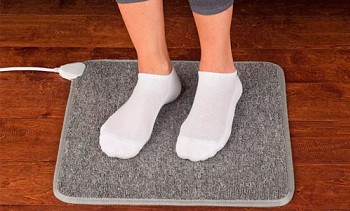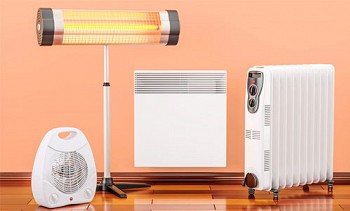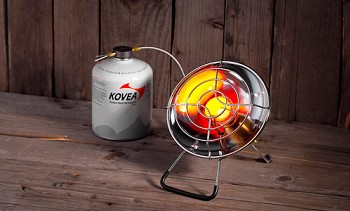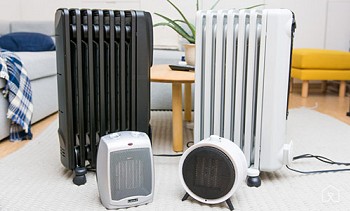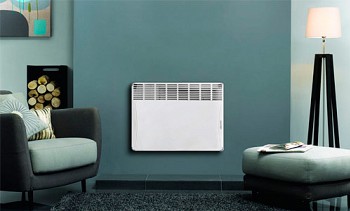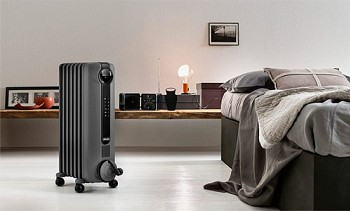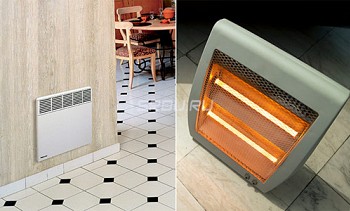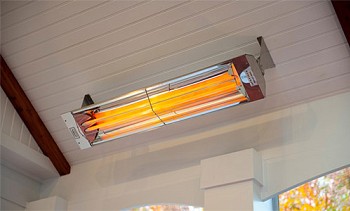As autumn begins to declare its rights openly, it becomes cold in unheated apartments, especially at night. So people rush to the store for heaters designed to bring the long-awaited warmth and comfort to the house. To make it easier for you, we offer a series of overview-type articles on the various types of these devices. So, before your eyes the first article of this cycle. It is dedicated to the currently popular oil heaters.
Today we will consider the principle of operation and design features of an oil-type electric heater. We will also talk about how to choose an oil heater for domestic needs, which should be paid close attention to and what points are absolutely unimportant. You will also find out what unpleasant consequences can be caused by improper operation of this device, and how to safely avoid this.
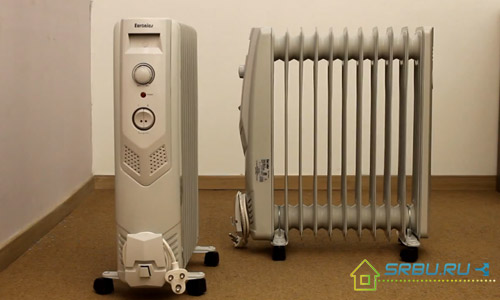
Oil heater design
The most important part of an oil type heater is, of course, the radiator. The material of its manufacture is ferrous metal, and the thickness is from 0.8 to 1 millimeter. Since the dimensions of all the elements of this product must be very accurate, laser cutting of metal is used for their manufacture, leaving behind an even edge and a smooth surface. Bending equipment is used to create right angles, and the smallest details are stamped.
Each section of the radiator must be airtight, so the parts of which it consists are welded together (by spot welding) and pressed. Before this, holes are made in them, which make it possible to assemble the radiator from separate sections using a nipple connection, which is impermeable and reliable. The paint applied to the radiator is very durable - because it is applied by powder technology and polymerized by heating in a special oven.
When the radiator is fully assembled, mineral type transformer oil is poured into it. In older models, there was a special valve for this, but now oil is poured directly during heater assembly. At the same time, an electric heater is installed inside the device, observing tightness, and outside - plastic and metal panels equipped with a thermostat, power regulator and overheat protection device. Also at this moment the power cable is connected.
For ease of use, the wheels are fastened with a bracket with nuts after the oil heater has taken its permanent place in the room.

The principle of operation of the oil type heater
Turning on the heater in the network, the first thing to do is set the regulator to the desired air temperature in the room. At the same time, ten (electric heat heater) is heated first, and then heat from it is transferred to the mineral oil. Then everything is simple: hot oil heats the radiator case, and he, in turn, gives off heat to the air in the apartment. The maximum to which heating of the body metal can occur is 150 degrees. However, for different models of heaters this threshold is different - it can be lower, but not higher than this temperature.

Do not believe the advertising gimmicks by the seller, who say with admiration that an oil heater can produce heat similar to a fireplace. This, in principle, cannot be - because, according to the laws of physics, warm air rises. This is how convection occurs.If we talk about radiation thermal radiation, then it heats only the fins of the radiator, sections of which are located opposite each other.
Choose an oil heater according to the parameters
Power
First of all, pay attention to power. It depends on what area will be heated. So, for 15 square meters, a heater with a power of at least 1.5 kilowatts is required. At the same time, it is understood that there is winter and severe frost on the street. True, the device will not last long in this mode - it will have to work at maximum strength. Therefore, for heating the same 15 square meters, you still need a 2 kilowatt heater.
At maximum, it will work only in the coldest days, and in the cool time - at half the power. If the room you plan to heat is small, then do not buy models of high power. So the device will constantly overheat, and the air in the room will not meet the standards.
Radiator Section Thickness
The second important parameter is the thickness of the radiator sections. Narrow sections heat up quickly, and they “eat” little electricity, only their total area is small. So they heat the air not very quickly. As for the wide sections, they will be too fast to cool the air, so there can be no question of saving electricity. What is more priority - the speed of heating the room or saving - you decide.
Power mode switch
When you buy a device, be sure to check if it has a power mode switch, an adjustable thermostat and an overheat protection function. Also, it is desirable to have such an option as automatic heating.

Humidifier
The air in the room during prolonged operation of any heater becomes extremely dry. Therefore, thinking about how to choose an oil heater for an apartment, it makes sense to dwell on models that have a special metal container for evaporating water. If desired, it can be easily removed.
Integrated fan
There is one way to quickly heat the air in a room. For this, a fan is placed next to the oil heater, turning it on at low power. At the same time, heat will quickly spread to all corners of the room. Some heaters already have a fan - it is built-in, and it is very convenient, since there is no need to connect additional devices. I pressed the fan heater button on the case - and you're done, the air in the room will heat up in two. Therefore, when deciding which oil cooler is best, give preference to a model that has a built-in fan.
Look at the safety of the model
For children's rooms, for example, manufacturers offer heaters with a casing that prevents the child from getting burned. Unfortunately, this casing slows down the process of moving heated air, otherwise, convection.

It looks like a radiator with a protective casing.
Instrument weight
When choosing an oil radiator, try it by weight - this is also important. And then some manufacturers save material, and an impressive-looking device will be completely light. Do not take such a model. There is one of two things: either the radiator is made of too thin metal, or there is not enough oil poured into it. Both of them are not very good.

Don't fall for the cunning sales consultants
- If you are told that a heater of any model does not dry the air, do not believe it - any device using convection will dry the air.
- All oil heaters do not burn dust (their heating elements do not come in contact with the room air), therefore this property cannot be a plus of a certain model.
- If the seller claims that only “this heater” does not raise the dust up, allow yourself to doubt it. After all, convection causes the movement of air, and with it the dust moves, especially stagnant.
- If you are told that a dark oil heater warms better than a light one, then this is again a lie. Most likely, sellers need to sell stale goods.Think for yourself: after all, in a radiator, heating does not occur with sunlight (in this case, really dark surfaces are heated more than light ones), but in a completely different way.
- Do not believe the existence of mythical oil-type wall heaters - they do not exist in nature. To prevent the device from overheating, they put it from the wall in half a meter, not closer.
Technical Parameters of Oil Heaters
| Options | Values |
|---|---|
| Number of sections | 3 to 14 pieces |
| Power | 500 to 3000 W |
| Heating area | Up to 31 m2 |
| Control | Electronic or mechanical |
| Height | 50 to 80 cm. |
| Width | 30 to 50 cm. |
| Weight | From 10 to 30 kg. |
| Type of shell | Accordion or covered with a protective cover |
| Fan heater | Availability varies by model. |
| Humidifier | Availability varies by model. |
| Rollover sensor | Availability varies by model. |
| Heated towel rail | Availability varies by model. |
| Auto power on | Availability varies by model. |
| Frost protection function | Availability varies by model. |
Errors in using the oil heater and their consequences
1. In humid rooms, for example, in a bathroom, it is extremely dangerous to use an oil-type heater - it can cause electric shock.
2. Do not touch the surface of the working device with your bare hand (of course, if it is not equipped with a casing) - burn yourself.
3. From the walls, place the heater no closer than half a meter, otherwise the thermal relay will constantly turn off the device. Also, do not cover the radiator with a cloth or other materials or dry wet clothes on it. Things can be dried on a removable hanger, which is placed at some distance from the radiator.
4. Lying on its side, the included oil heater starts to pose a danger. Hot oil can break the radiator and cause a fire. After all, it does not pour to the very top, and in a position on its side it flows down from the heating element, which, when exposed, is heated to 800 degrees. The result is a radiator rupture and unpredictable consequences. Hot oil can cause serious injuries to someone who accidentally happens to be around at that moment.
5. If the overheating sensor is faulty, never turn on the heater in the mains - it will also be dangerous. Indeed, in this case, the device will stop turning off, basking indefinitely. As a result, the likelihood of a rupture of the metal case and a fire appears again.
6. If in winter you decide to store the oil heater in an unheated room, for example, in a garage, you can say goodbye to him forever - the radiator case will be damaged and oil will leak.
7. Never drag the appliance around the room by the power cord - this is fraught with a wire break or short circuit.
Thus, we told you how to choose the right oil heater. Read about other types of radiators in the following reviews.
Video: Choosing an oil heater

